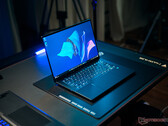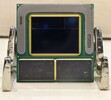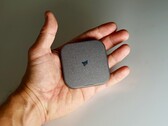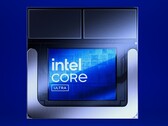
Slim OLED gamer with RTX 5070 and Lunar Lake - Acer Predator Triton 14 AI review
Intel Core Ultra 9 288V | NVIDIA GeForce RTX 5070 Laptop | 14.50" | 1.6 kg

The Intel Core Ultra 7 288V is the fastest Lunar Lake family processor as of Nov 2024 thanks to its higher TDP power target and higher clock speeds. This is an SoC for use in tablets and laptops of the slimmer kind that was unveiled in Autumn 2024. It sports 4 new Skymont E-cores and 4 new Lion Cove P-cores running at up to 3.7 GHz and 5.1 GHz respectively, along with the promising new Arc 140V iGPU and 32 GB of on-package, non-replaceable LPDDR5x-8533 RAM. A new 48 TOPS neural engine, Thunderbolt 4 and PCIe 5 SSD support are included as well. A vPro-enabled version of the CPU became available in early 2025.
Architecture and Features
Lunar Lake is built using the Foveros technology (stacking several dies on top of each other and next to each other), just like Meteor Lake was. The new chips make use of the enormous BGA2833 socket interface. Of the 8 cores, not a single one is Hyper-Threading-enabled which is the opposite of what AMD currently does with its Zen 5/5c chips.
Intel claims Lion Cove cores bring a 14% IPC improvement over Redwood Cove. For Skymont and Crestmont, the difference is much higher at 68%. Several tweaks and improvements are present here, such as the Low Latency Fabric that is supposed to make small data transfers between cores/caches a lot faster. The 288V has a very healthy 12 MB of level 3 cache; elsewhere, it has 4 PCIe 5 and 4 PCIe 4 lanes for connecting various kinds of devices, including NVMe SSDs at up to 15.75 GB/s. Thunderbolt 4 support is onboard by default, as is support for CNVi WiFi 7 + BT 5.4 cards from Intel. The 48 TOPS "AI Boost" neural engine is present along with technologies such as Threat Detection to make AI-enabled applications such as the Windows Defender more powerful.
Intel is predicted to get short of on-package RAM in subsequent CPU generations.
Performance
The 288V should be just a couple of percentage points faster than the Core Ultra 7 165U and Core i7-1360P in multi-threaded tasks.
Generally speaking, the 256V, 258V, 266V, 268V, 288V are faster than the 226V, 228V, 236V and 228V due to the difference in their last-level cache size (8 MB vs 12 MB) as well as clock speeds. However, the difference in performance between the slowest Lunar Lake chip, the 226V, and the fastest chip, the 288V is fairly small at around 10% to 15%. It depends on the TDP figures of the laptops being pitted against each other more than on anything else.
Graphics
The Arc Graphics 140V is here to replace the Arc 8 iGPU. Its 8 Xe² architecture "cores" run at up to 2,050 MHz and it also has 8 ray tracing units at its disposal. The adapter is DirectX 12 Ultimate-enabled and able to HW-decode a long list of popular video codecs such as h.266 VVC, h.265 HEVC, h.264 AVC, AV1 and VP9. Three SUHD 4320p monitors can be used simultaneously with this iGPU.
All 2023 and 2024 games are playable at 1080p on low graphics settings or higher with this iGPU. We got well over 30 fps in Ghost of Tsushima and almost 40 fps in Baldur's Gate 3. This means the Radeon 780M gets left behind while the Radeon 890M reigns supreme.
Power consumption
Unlike the slower 268V, 266V, 258V, 256V, 238V, 236V, 228V and 226V, this 2nd generation Core Ultra processor is supposed to consume 30 W when under long-term workloads rather than 17 W. The Intel-recommended short-term power limit for all of them is identical: 37 W.
| Codename | Lunar Lake | ||||||||||||||||||||||||||||||||||||
| Series | Intel Lunar Lake | ||||||||||||||||||||||||||||||||||||
Series: Lunar Lake Lunar Lake
| |||||||||||||||||||||||||||||||||||||
| Clock Rate | 3300 - 5100 MHz | ||||||||||||||||||||||||||||||||||||
| Level 1 Cache | 1.4 MB | ||||||||||||||||||||||||||||||||||||
| Level 2 Cache | 14 MB | ||||||||||||||||||||||||||||||||||||
| Level 3 Cache | 12 MB | ||||||||||||||||||||||||||||||||||||
| Number of Cores / Threads | 8 / 8 4 x 5.1 GHz Intel Lion Cove P-Core 4 x 3.7 GHz Intel Skymont E-Core | ||||||||||||||||||||||||||||||||||||
| Power Consumption (TDP = Thermal Design Power) | 30 Watt | ||||||||||||||||||||||||||||||||||||
| TDP Turbo PL2 | 37 Watt | ||||||||||||||||||||||||||||||||||||
| Manufacturing Technology | 3 nm | ||||||||||||||||||||||||||||||||||||
| Max. Temperature | 100 °C | ||||||||||||||||||||||||||||||||||||
| Socket | BGA2833 | ||||||||||||||||||||||||||||||||||||
| Features | LPDDR5x-8533 RAM, PCIe 5 + PCIe 4, USB 4, AI Boost NPU (48 TOPS), Thread Director, PSE, Threat Detection, MMX, SSE, SSE2, SSE3, SSSE3, SSE4.1, SSE4.2, AES, AVX, AVX2, AVX-VNNi, FMA3, SHA | ||||||||||||||||||||||||||||||||||||
| GPU | Intel Arc Graphics 140V (300 - 2050 MHz) | ||||||||||||||||||||||||||||||||||||
| NPU / AI | 48 TOPS INT8 | ||||||||||||||||||||||||||||||||||||
| Chip AI | 120 TOPS INT8 | ||||||||||||||||||||||||||||||||||||
| 64 Bit | 64 Bit support | ||||||||||||||||||||||||||||||||||||
| Architecture | x86 | ||||||||||||||||||||||||||||||||||||
| Announcement Date | 09/03/2024 | ||||||||||||||||||||||||||||||||||||
| Product Link (external) | ark.intel.com | ||||||||||||||||||||||||||||||||||||





Medion Sprchrgd 16 S1: Intel Arc Graphics 140V, 16.00", 1.5 kg
External Review » Medion Sprchrgd 16 S1
Acer Swift Edge 14 AI SFE14-51, Ultra 9 288V: Intel Arc Graphics 140V, 14.00", 1 kg
External Review » Acer Swift Edge 14 AI SFE14-51, Ultra 9 288V
HP OmniBook Ultra Flip 14, Ultra 9 288V: Intel Arc Graphics 140V, 14.00", 1.3 kg
External Review » HP OmniBook Ultra Flip 14, Ultra 9 288V
Acer Predator Triton 14 AI PT14-52: NVIDIA GeForce RTX 5070 Laptop, 14.50", 1.6 kg
External Review » Acer Predator Triton 14 AI PT14-52
Acer Swift 16 AI SF16-51, Ultra 9 288V: Intel Arc Graphics 140V, 16.00", 1.5 kg
External Review » Acer Swift 16 AI SF16-51, Ultra 9 288V
MSI Prestige 16 AI+ Evo B2VMG: Intel Arc Graphics 140V, 16.00", 1.5 kg
External Review » MSI Prestige 16 AI+ Evo B2VMG
Asus Zenbook S 14 UX5406 Core Ultra 9: Intel Arc Graphics 140V
External Review » Asus Zenbook S 14 UX5406 Core Ultra 9
Acer Predator Triton 14 AI PT14-52: NVIDIA GeForce RTX 5070 Laptop, 14.50", 1.6 kg
» Acer's Predator Triton 14 AI with the RTX 5070 for $2599 is simply too expensive
Acer Swift 16 AI SF16-51T-932H, Ultra 9 288V: Intel Arc Graphics 140V, 16.00", 1.5 kg
» Acer Swift 16 AI with 2.8K 120 Hz OLED touchscreen and Core Ultra 256V drops under $750
MSI Prestige 16 AI+ Evo B2VMG: Intel Arc Graphics 140V, 16.00", 1.5 kg
» Ultrabook with Lunar Lake and 4K OLED: MSI Prestige 16 AI+ Mercedes-AMG Limited Edition now available
Acer Predator Triton 14 AI PT14-52: NVIDIA GeForce RTX 5070 Laptop, 14.50", 1.6 kg
» Acer Predator Triton 14 AI with haptic trackpad, Lunar Lake and light chassis launches in more markets
Acer Swift 16 AI SF16-51T-932H, Ultra 9 288V: Intel Arc Graphics 140V, 16.00", 1.5 kg
» Acer Swift 16 AI review verdict: Brilliant OLED and a great bang for the buck
Asus Zenbook S 14 UX5406 Core Ultra 9: Intel Arc Graphics 140V
» Asus Zenbook 14 OLED laptop with long battery life and Core Ultra 7 155H is selling at affordable price
» Intel Arc 140T graphics delivers 60 percent performance boost over Lunar Lake variant
» Mobile CPU Comparison
Comparison of all mobile CPU series
» Mobile Processors - Benchmarklist
Benchmarklist of all known CPUs that are used in laptops (desktop and laptop CPUs)
Top 10 Laptops
Multimedia, Budget Multimedia, Gaming, Budget Gaming, Lightweight Gaming, Business, Budget Office, Workstation, Subnotebooks, Ultrabooks, Chromebooks
under 300 USD/Euros, under 500 USD/Euros, 1,000 USD/Euros, for University Students, Best Displays
Top 10 Smartphones
Smartphones, Phablets, ≤6-inch, Camera Smartphones